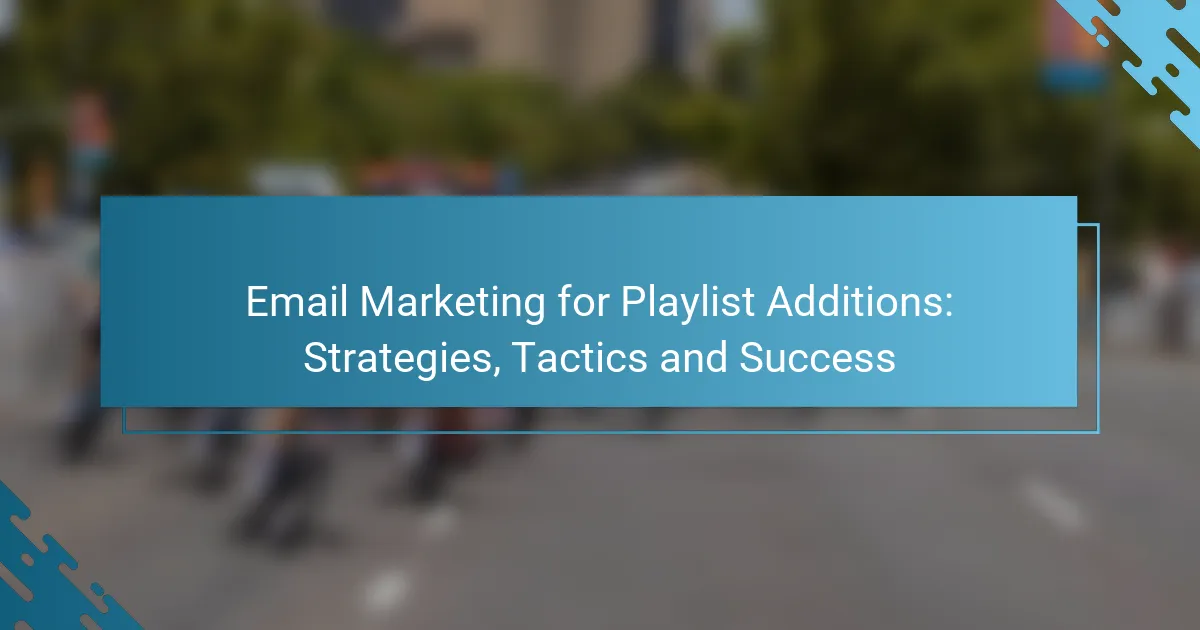Email marketing is a powerful tool for musicians looking to boost their playlist additions by fostering direct connections with their audience. By implementing targeted campaigns and personalized content, artists can effectively promote their music while tracking engagement metrics to optimize their strategies. Building a dedicated subscriber list and utilizing the right tools can further enhance these efforts, leading to greater visibility and success in the competitive music landscape.
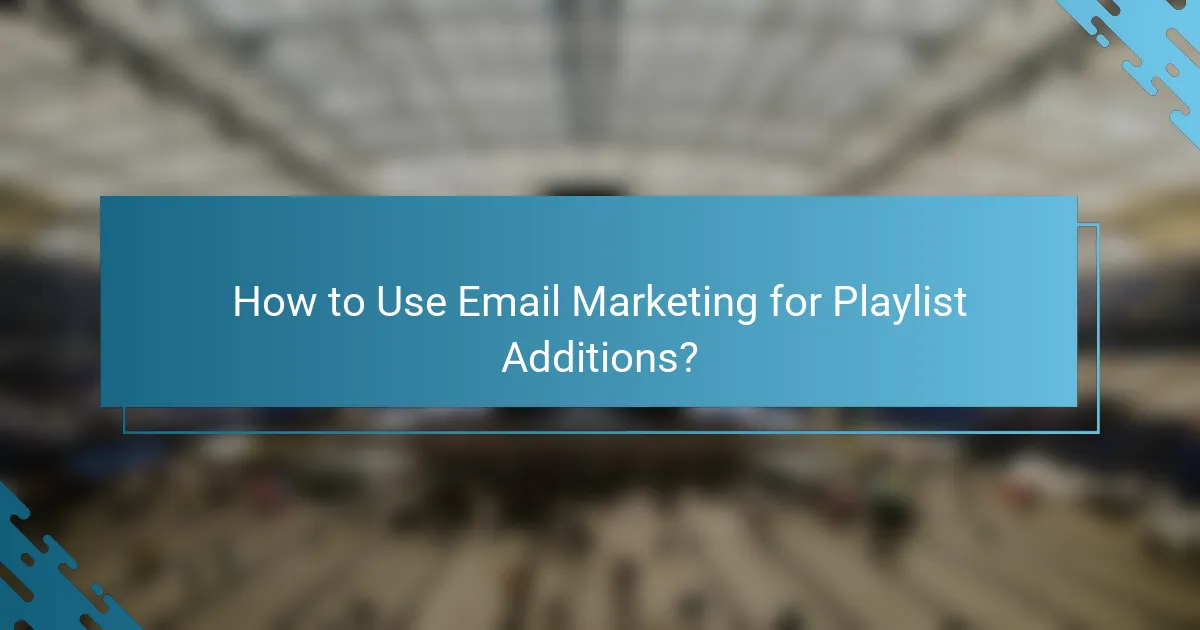
How to Use Email Marketing for Playlist Additions?
Email marketing can effectively promote your music and increase playlist additions by directly engaging with your audience. By leveraging targeted campaigns, personalized content, and tracking engagement metrics, you can enhance your chances of getting your tracks featured on popular playlists.
Targeted email campaigns
Targeted email campaigns focus on specific segments of your audience to increase relevance and engagement. By analyzing listener data, you can tailor your messages to different demographics, such as age, location, or listening habits. For example, sending a special release announcement to fans who have previously engaged with similar genres can yield better results.
Consider using A/B testing to refine your campaigns. Test different subject lines or content formats to see which resonates more with your audience. This approach helps optimize your email strategy over time.
Personalized content strategies
Personalized content strategies involve customizing your emails based on individual preferences and behaviors. Use the recipient’s name, recommend tracks based on their listening history, or share exclusive content that aligns with their interests. This level of personalization can significantly increase open and click-through rates.
Incorporate dynamic content that changes based on user data. For instance, if a subscriber frequently listens to a specific genre, highlight new releases in that genre to keep them engaged and encourage playlist additions.
Engagement metrics tracking
Tracking engagement metrics is crucial for understanding the effectiveness of your email marketing efforts. Key metrics to monitor include open rates, click-through rates, and conversion rates related to playlist additions. Analyzing these metrics helps you identify what works and what needs improvement.
Utilize tools like Google Analytics or email marketing platforms that provide detailed insights. Regularly review this data to adjust your strategies and enhance future campaigns.
Call-to-action optimization
Optimizing your call-to-action (CTA) is essential for driving actions like playlist additions. Ensure your CTAs are clear, compelling, and strategically placed within your emails. Use action-oriented language that encourages immediate engagement, such as “Add to Your Playlist” or “Listen Now.”
Experiment with different CTA designs and placements to see what drives the most clicks. A/B testing can help you determine the most effective wording and button styles for your audience.
Segmentation techniques
Segmentation techniques involve dividing your email list into smaller groups based on specific criteria. This allows for more targeted messaging that resonates with each group’s unique preferences. Common segmentation criteria include location, past purchase behavior, and engagement levels.
Implementing segmentation can significantly enhance your email marketing effectiveness. For instance, you might send different content to active listeners versus those who haven’t engaged recently, encouraging re-engagement and playlist additions from both groups.

What Are Effective Email Marketing Strategies for Musicians?
Effective email marketing strategies for musicians focus on building a dedicated subscriber list, crafting engaging subject lines, and leveraging A/B testing to optimize campaigns. These approaches help musicians connect with their audience, promote their music, and increase playlist additions.
Building a subscriber list
Building a subscriber list is essential for musicians looking to enhance their email marketing efforts. Start by collecting email addresses through your website, social media platforms, and live events. Offering incentives, such as exclusive content or discounts on merchandise, can significantly boost sign-ups.
Utilize tools like Mailchimp or ConvertKit to manage your list effectively. Ensure compliance with regulations such as GDPR if you are targeting audiences in Europe, which requires explicit consent for data collection.
Creating compelling subject lines
Compelling subject lines are crucial for increasing open rates in your email campaigns. Aim for clarity and intrigue, keeping them under 50 characters to ensure they display well on mobile devices. Phrases like “Exclusive New Track” or “Join My Upcoming Live Stream” can capture attention effectively.
Consider personalizing subject lines with the recipient’s name or location to create a connection. Avoid using spammy words like “free” or “urgent,” which can trigger spam filters and reduce deliverability.
Utilizing A/B testing
A/B testing allows musicians to compare different email elements to determine what resonates best with their audience. Test variables such as subject lines, send times, and content layout to identify the most effective combinations. Start with small changes to gauge their impact before implementing broader adjustments.
Track metrics like open rates and click-through rates to assess performance. Aim for a testing period of at least a week to gather sufficient data, and use the insights gained to refine future campaigns for better engagement and playlist additions.
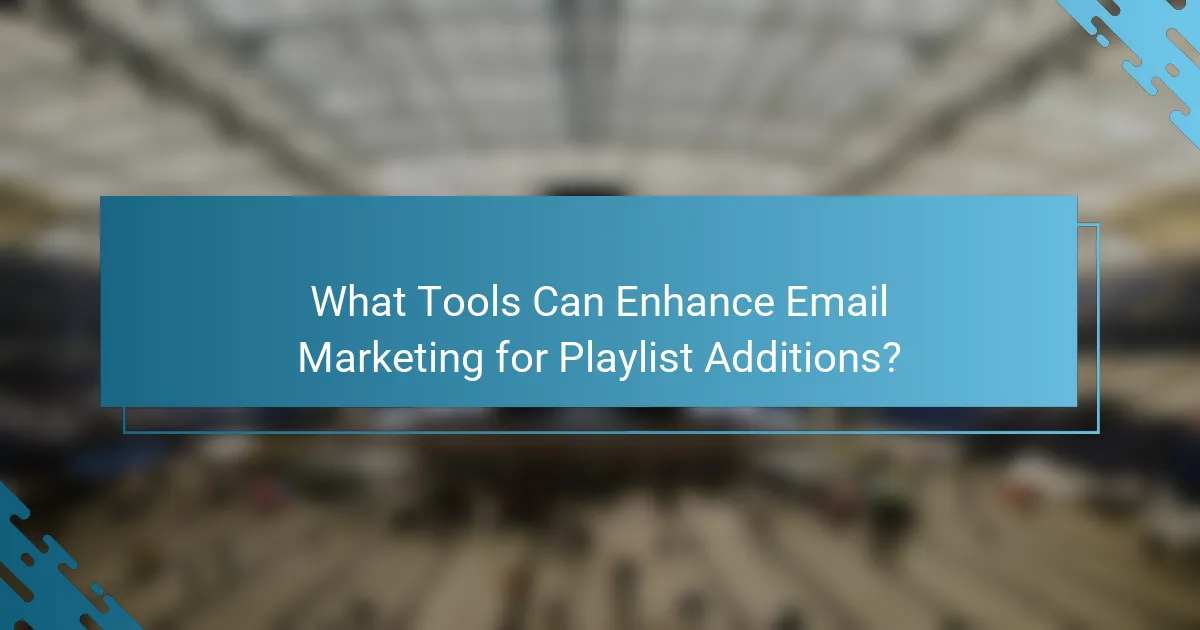
What Tools Can Enhance Email Marketing for Playlist Additions?
Utilizing the right tools can significantly improve your email marketing efforts for playlist additions. These tools help automate processes, enhance engagement, and provide valuable insights into your audience’s preferences.
Mailchimp for automation
Mailchimp is a powerful email marketing platform that excels in automation features. With its user-friendly interface, you can set up automated campaigns that trigger based on user actions, such as opening an email or clicking a link. This ensures timely follow-ups and keeps your audience engaged.
Consider using Mailchimp’s segmentation tools to tailor your messages to different audience groups. For example, you can create specific campaigns for fans of particular genres or those who have previously engaged with your music. This targeted approach can lead to higher open and click-through rates.
ConvertKit for creators
ConvertKit is designed specifically for creators, making it an excellent choice for musicians looking to grow their audience. Its simple yet effective email builder allows you to create visually appealing emails that showcase your music and playlists. You can also use landing pages to capture email sign-ups directly from your promotional efforts.
One of ConvertKit’s standout features is its tagging system, which helps you categorize subscribers based on their interests. This allows for personalized communication, increasing the likelihood of playlist additions as you can send tailored content that resonates with each subscriber.
Sendinblue for analytics
Sendinblue offers robust analytics tools that provide insights into your email marketing performance. You can track metrics such as open rates, click rates, and conversion rates, allowing you to assess the effectiveness of your campaigns. Understanding these metrics is crucial for optimizing future email strategies.
Utilize Sendinblue’s A/B testing feature to experiment with different subject lines or content formats. This can help you identify what resonates best with your audience, leading to improved engagement and more playlist additions. Regularly reviewing your analytics will ensure you stay aligned with your audience’s preferences.
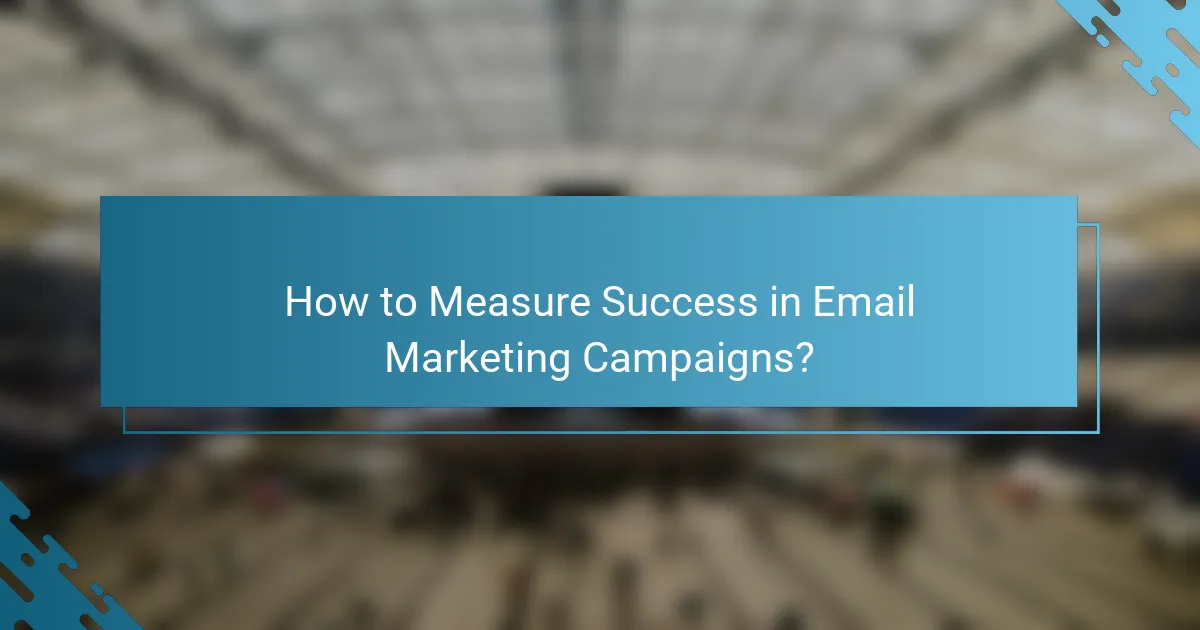
How to Measure Success in Email Marketing Campaigns?
Measuring success in email marketing campaigns involves analyzing key performance indicators (KPIs) such as open rates, click-through rates, and conversion rates. These metrics provide insights into how effectively your emails engage recipients and drive desired actions.
Open rates analysis
Open rates indicate the percentage of recipients who opened your email, reflecting the effectiveness of your subject lines and sender reputation. A typical open rate can range from 15% to 25%, depending on the industry and audience.
To improve open rates, consider A/B testing different subject lines and sending times. Avoid spammy words that could trigger filters and ensure your email list is clean and targeted to enhance engagement.
Click-through rates evaluation
Click-through rates (CTR) measure the percentage of recipients who clicked on links within your email. A good CTR generally falls between 2% and 5%, but this can vary based on content relevance and audience interest.
To boost CTR, use clear and compelling calls to action (CTAs) and ensure your email design is mobile-friendly. Segment your audience to tailor content specifically to their preferences, increasing the likelihood of clicks.
Conversion tracking
Conversion tracking assesses how many recipients completed a desired action after clicking through your email, such as signing up for a playlist or making a purchase. This metric is crucial for understanding the overall effectiveness of your campaign.
Implement tracking pixels or unique URLs to monitor conversions accurately. Set clear goals for each campaign and analyze the data to refine your strategies, ensuring you focus on what drives the most valuable actions from your audience.

What Are Common Challenges in Email Marketing for Playlist Additions?
Email marketing for playlist additions faces several challenges that can hinder success. Key issues include spam filters affecting deliverability, maintaining subscriber interest, and ensuring content remains relevant and appropriately timed.
Spam filters and deliverability issues
Spam filters are a significant hurdle in email marketing, as they can prevent your messages from reaching subscribers’ inboxes. To improve deliverability, ensure your email list is clean and that you comply with regulations like the CAN-SPAM Act in the U.S. or GDPR in Europe.
Using a verified sending domain and authenticating your emails with SPF, DKIM, and DMARC can enhance your credibility. Regularly monitoring your sender reputation and engagement metrics will help you identify and resolve deliverability problems quickly.
Maintaining subscriber engagement
Keeping subscribers engaged is crucial for the success of your email campaigns. High engagement rates lead to better deliverability and increased chances of playlist additions. Segment your audience based on their preferences and behaviors to tailor your content effectively.
Consider using personalized subject lines and dynamic content to capture attention. Regularly analyze open and click-through rates to refine your approach and identify what resonates with your audience.
Content relevance and frequency
Content relevance and frequency are vital for sustaining subscriber interest in your emails. Sending too many emails can lead to unsubscribes, while infrequent communication may cause your audience to forget about you. A balanced approach is essential.
Establish a consistent schedule, such as bi-weekly or monthly newsletters, and focus on delivering valuable content that aligns with your subscribers’ interests. Use A/B testing to determine the optimal frequency and content type that drives engagement without overwhelming your audience.
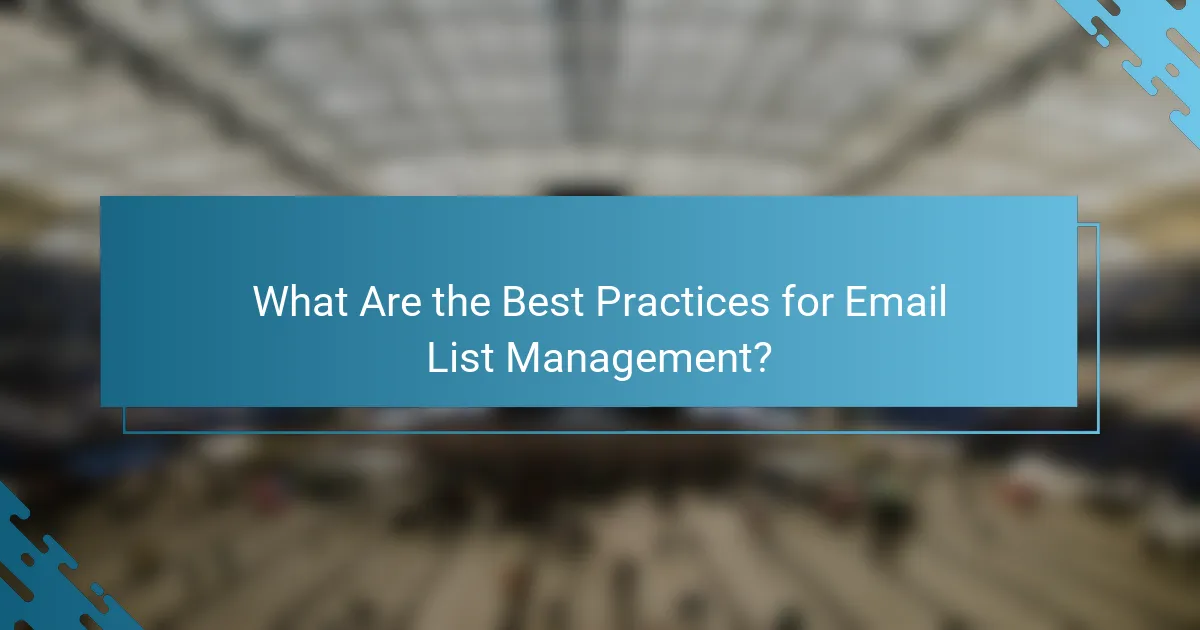
What Are the Best Practices for Email List Management?
Effective email list management is crucial for maximizing engagement and ensuring successful email marketing campaigns. Key practices include regular list cleaning, segmentation, and compliance with regulations like GDPR.
Regular list cleaning
Regular list cleaning involves removing inactive subscribers and invalid email addresses to maintain a healthy email list. This process helps improve deliverability rates and engagement metrics, ensuring your emails reach engaged recipients.
To effectively clean your list, consider implementing a routine check every few months. Look for subscribers who haven’t opened your emails in the last six months or who have bounced repeatedly. A good rule of thumb is to aim for a list that maintains at least a 70% engagement rate.
When cleaning your list, you can use automated tools that identify inactive users and send re-engagement campaigns. If users do not respond after a second attempt, it’s often best to remove them to keep your list focused and effective.
